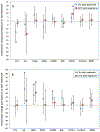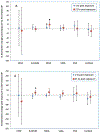Metals and oxidative potential in urban particulate matter influence systemic inflammatory and neural biomarkers: A controlled exposure study
- PMID: 30420132
- PMCID: PMC6396878
- DOI: 10.1016/j.envint.2018.10.055
Metals and oxidative potential in urban particulate matter influence systemic inflammatory and neural biomarkers: A controlled exposure study
Abstract
Background: Oxidative stress and inflammation are considered to be important pathways leading to particulate matter (PM)-associated disease. In this exploratory study, we examined the effects of metals and oxidative potential (OP) in urban PM on biomarkers of systemic inflammation, oxidative stress and neural function.
Methods: Fifty-three healthy non-smoking volunteers (mean age 28 years, twenty-eight females) were exposed to coarse (2.5-10 μm, mean 213 μg/m3), fine (0.15-2.5 μm, 238 μg/m3), and/or ultrafine concentrated ambient PM (<0.3 μm, 136 μg/m3). Exposures lasted 130 min, separated by ≥2 weeks. Metal concentrations and OP (measured by ascorbate and glutathione depletion in synthetic airway fluid) in PM were analyzed. Blood and urine samples were collected pre-exposure, and 1-h and 21-h post exposure for assessment of biomarkers. We used mixed-regression models to analyze associations adjusting for PM size and mass concentration.
Results: Results for metals were expressed as change (%) from daily pre-exposure biomarker levels after exposure to a metal at a level equivalent to the mean concentration. Exposure to various metals (silver, aluminum, barium, copper, iron, potassium, lithium, nickel, tin, and/or vanadium) was significantly associated with increased levels of various blood or urinary biomarkers. For example, the blood inflammatory marker vascular endothelia growth factor (VEGF) increased 5.3% (95% confidence interval: 0.3%, 10.2%) 1-h post exposure to nickel; the traumatic brain injury marker ubiquitin C-terminal hydrolase L1 (UCHL1) increased 11% (1.2%, 21%) and 14% (0.3%, 29%) 1-h and 21-h post exposure to barium, respectively; and the systemic stress marker cortisol increased 1.5% (0%, 2.9%) and 1.5% (0.5%, 2.8%) 1-h and 21-h post exposure to silver, respectively. Urinary DNA oxidation marker 8‑hydroxy‑deoxy‑guanosine increased 14% (6.4%, 21%) 1-h post exposure to copper; urinary neural marker vanillylmandelic acid increased 29% (3%, 54%) 1-h post exposure to aluminum; and urinary cortisol increased 88% (0.9%, 176%) 1-h post exposure to vanadium. Results for OP were expressed as change (%) from daily pre-exposure biomarker levels after exposure to ascorbate-related OP at a level equivalent to the mean concentration, or for exposure to glutathione-related OP at a level above the limit of detection. Exposure to ascorbate- or glutathione-related OP was significantly associated with increased inflammatory and neural biomarkers including interleukin-6, VEGF, UCHL1, and S100 calcium-binding protein B in blood, and malondialdehyde and 8-hydroxy-deoxy-guanosine in urine. For example, UCHL1 increased 9.4% (1.8%, 17%) in blood 21-h post exposure to ascorbate-related OP, while urinary malondialdehyde increased 19% (3.6%, 35%) and 8-hydroxy-deoxy-guanosine increased 24% (2.9%, 48%) 21-h post exposure to ascorbate- and glutathione-related OP, respectively.
Conclusion: Our results from this exploratory study suggest that metal constituents and OP in ambient PM may influence biomarker levels associated with systemic inflammation, oxidative stress, perturbations of neural function, and systemic physiological stress.
Crown Copyright © 2018. Published by Elsevier Ltd. All rights reserved.
Figures


Similar articles
-
Influence of exposure to coarse, fine and ultrafine urban particulate matter and their biological constituents on neural biomarkers in a randomized controlled crossover study.Environ Int. 2017 Apr;101:89-95. doi: 10.1016/j.envint.2017.01.010. Epub 2017 Jan 20. Environ Int. 2017. PMID: 28117141 Free PMC article. Clinical Trial.
-
Effects of ambient coarse, fine, and ultrafine particles and their biological constituents on systemic biomarkers: a controlled human exposure study.Environ Health Perspect. 2015 Jun;123(6):534-40. doi: 10.1289/ehp.1408387. Epub 2015 Jan 16. Environ Health Perspect. 2015. PMID: 25616223 Free PMC article. Clinical Trial.
-
Associations of oxidative stress and inflammatory biomarkers with chemically-characterized air pollutant exposures in an elderly cohort.Environ Res. 2016 Oct;150:306-319. doi: 10.1016/j.envres.2016.06.019. Epub 2016 Jun 21. Environ Res. 2016. PMID: 27336235 Free PMC article.
-
Review of Acellular Assays of Ambient Particulate Matter Oxidative Potential: Methods and Relationships with Composition, Sources, and Health Effects.Environ Sci Technol. 2019 Apr 16;53(8):4003-4019. doi: 10.1021/acs.est.8b03430. Epub 2019 Apr 3. Environ Sci Technol. 2019. PMID: 30830764 Review.
-
Ambient particulate matter oxidative potential: Chemical determinants, associated health effects, and strategies for risk management.Free Radic Biol Med. 2020 May 1;151:7-25. doi: 10.1016/j.freeradbiomed.2020.04.028. Epub 2020 May 11. Free Radic Biol Med. 2020. PMID: 32430137 Review.
Cited by
-
Oxidative Potential Versus Biological Effects: A Review on the Relevance of Cell-Free/Abiotic Assays as Predictors of Toxicity from Airborne Particulate Matter.Int J Mol Sci. 2019 Sep 26;20(19):4772. doi: 10.3390/ijms20194772. Int J Mol Sci. 2019. PMID: 31561428 Free PMC article. Review.
-
Achieving health-oriented air pollution control requires integrating unequal toxicities of industrial particles.Nat Commun. 2023 Oct 14;14(1):6491. doi: 10.1038/s41467-023-42089-6. Nat Commun. 2023. PMID: 37838777 Free PMC article.
-
Personal exposure to PM2.5 oxidative potential and its association to birth outcomes.J Expo Sci Environ Epidemiol. 2023 May;33(3):416-426. doi: 10.1038/s41370-022-00487-w. Epub 2022 Nov 11. J Expo Sci Environ Epidemiol. 2023. PMID: 36369373
-
Mechanistic Insights into the Role of Iron, Copper, and Carbonaceous Component on the Oxidative Potential of Ultrafine Particulate Matter.Chem Res Toxicol. 2021 Mar 15;34(3):767-779. doi: 10.1021/acs.chemrestox.0c00399. Epub 2021 Mar 2. Chem Res Toxicol. 2021. PMID: 33651939 Free PMC article.
-
Particulate Matter and Associated Metals: A Link with Neurotoxicity and Mental Health.Atmosphere (Basel). 2021 Apr;12(4):425. doi: 10.3390/atmos12040425. Epub 2021 Mar 26. Atmosphere (Basel). 2021. PMID: 38094216 Free PMC article.
References
-
- Anderson JL, Carlquist JF, Muhlestein JB, Horne BD, Elmer SP. 1998. Evaluation of C-reactive protein, an inflammatory marker, and infectious serology as risk factors for coronary artery disease and myocardial infarction. J Am Coll Cardio 32: 35–41. - PubMed
-
- Ayres JG, Borm P, Cassee F, Castranova V, Donaldson K, Ghio A, et al. 2008. Evaluating the toxicity of airborne particulate matter and nanoparticles by measuring oxidative stress potential--a workshop report and consensus statement. Inhal Toxicol 20: 75–99. - PubMed
-
- Baker MA, Cerniglia GJ, Zaman A. 1990. Microtiter plate assay for the measurement of glutathione and glutathione disulfide in large numbers of biological samples. Anal Biochem 190: 360–365. - PubMed
-
- Bates JT, Weber RJ, Abrams J, Verma V, Fang T, Klein M, et al. 2015. Reactive oxygen species generation linked to sources of atmospheric particulate matter and cardiorespiratory effects. Environ Sci Technol 49: 13605–13612. - PubMed
Publication types
MeSH terms
Substances
Grants and funding
LinkOut - more resources
Full Text Sources
Miscellaneous

